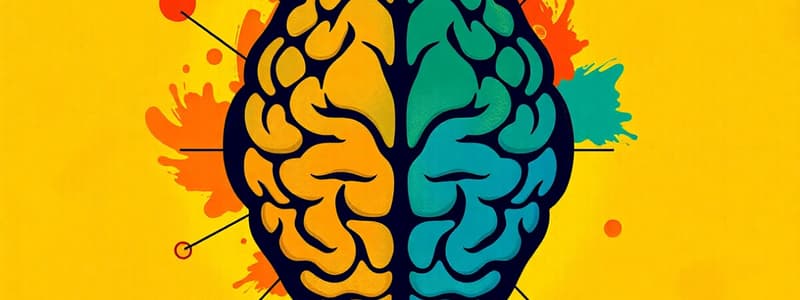Podcast
Questions and Answers
Which of the following characteristics is NOT typically associated with left-brained learners?
Which of the following characteristics is NOT typically associated with left-brained learners?
- Analytical thinking
- Logical reasoning
- Detail-oriented
- Creative expression (correct)
What percentage of students in a classroom is estimated to be tactile/kinesthetic learners?
What percentage of students in a classroom is estimated to be tactile/kinesthetic learners?
- 50%
- 25%
- 15% (correct)
- 30%
What is one suggested approach for right-brained learners in a classroom setting?
What is one suggested approach for right-brained learners in a classroom setting?
- Engaging in systematic learning methods
- Using visual aids and metaphors (correct)
- Studying in a quiet environment
- Creating lists and outlines
In the classroom, what percentage range is associated with students who use mixed modalities in their learning?
In the classroom, what percentage range is associated with students who use mixed modalities in their learning?
Which learning modality would likely prefer a hands-on activity for a social problem presentation?
Which learning modality would likely prefer a hands-on activity for a social problem presentation?
Which modality refers to how individuals perceive information through their senses?
Which modality refers to how individuals perceive information through their senses?
Which of the following is a characteristic of visual learners?
Which of the following is a characteristic of visual learners?
What type of learner benefits most from engaging in discussions and listening to lectures?
What type of learner benefits most from engaging in discussions and listening to lectures?
Which of the following abilities is least likely to be found in visual learners?
Which of the following abilities is least likely to be found in visual learners?
Which sensory modality is linked with processors who easily remember things they have seen?
Which sensory modality is linked with processors who easily remember things they have seen?
What is a common trait of auditory learners?
What is a common trait of auditory learners?
Which of the following preferences is likely to be exhibited by visual learners?
Which of the following preferences is likely to be exhibited by visual learners?
Which of these descriptions does NOT fit a visual learner?
Which of these descriptions does NOT fit a visual learner?
Which characteristic is most commonly associated with auditory learners?
Which characteristic is most commonly associated with auditory learners?
What is a typical learning preference for kinesthetic learners?
What is a typical learning preference for kinesthetic learners?
Which of the following is NOT a common behavior of auditory learners?
Which of the following is NOT a common behavior of auditory learners?
How do kinesthetic learners typically memorize information?
How do kinesthetic learners typically memorize information?
Which preference is likely to be found in auditory learners?
Which preference is likely to be found in auditory learners?
Which of the following best describes the processing preference of auditory learners?
Which of the following best describes the processing preference of auditory learners?
Which statement reflects a misconception about kinesthetic learners?
Which statement reflects a misconception about kinesthetic learners?
What might be a challenge for auditory learners?
What might be a challenge for auditory learners?
Flashcards are hidden until you start studying
Study Notes
Learning Styles: Modality and Brain Dominance
- Learning style theories categorize how individuals prefer to receive and process information.
- Two key theories are based on modality (how we perceive information) and brain dominance (how we process information).
Modality Learning Styles
- Visual Learners: Learn by seeing; prefer diagrams, text, and visual aids.
- Characteristics: Neat, quick speakers, good planners, observant, appearance-oriented, good spellers, strong readers.
- Preferences: Drawing, design, visual arts, film, art therapy, mathematics, physics.
- Auditory Learners: Learn by hearing; prefer lectures, discussions, and verbal explanations.
- Characteristics: Talk to themselves, easily distracted by noise, move lips while reading, enjoy reading aloud, good at mimicking, find writing difficult.
- Preferences: Language, drama, music, training, lecturing, talking therapies.
- Kinesthetic Learners: Learn through physical activity and hands-on experiences.
- Characteristics: Speak slowly, respond to physical rewards, touch people for attention, physically oriented, learn by doing, messy handwriting.
- Preferences: Sport, carpentry, gymnastics, athletics, body work therapies.
- Classroom distribution: Approximately 25-30% visual, 25-30% auditory, 15% tactile/kinesthetic, 25-30% mixed modalities.
Brain Dominance
- Left-Brained Learners: Logical, analytical, detail-oriented; prefer structured approaches and systematic learning.
- Right-Brained Learners: Creative, intuitive, holistic; prefer visual aids, metaphors, and imaginative approaches.
Class Activities
- Activity 1: Identify the modality learning style of each group member.
- Activity 2: Teams (two people with the same preferred modality) choose a social problem, define it, explain its reasons and effects, and propose solutions. Presentation methods should align with the team's learning style (e.g., hands-on activity for kinesthetic learners, presentation for auditory learners, visual aid for visual learners).
Studying That Suits You
Use AI to generate personalized quizzes and flashcards to suit your learning preferences.





